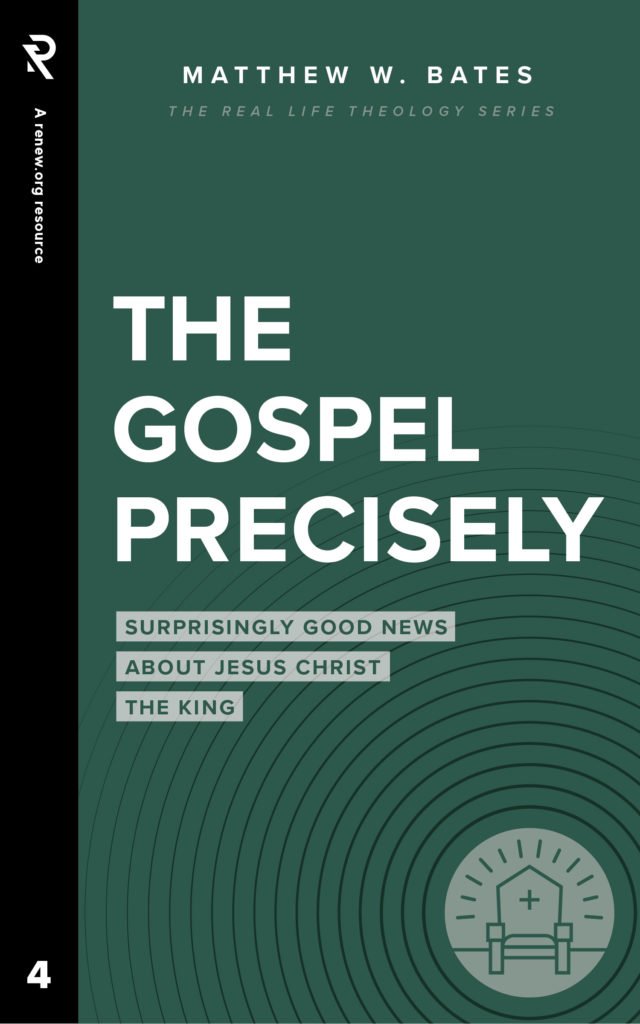
Jesus Was the Messiah. So, What’s a “Messiah”? Q&A with Jon Kehrer
Around Christmas, we often hear how Jesus was the Messiah, a long-awaited figure who would arrive and rescue people from their sins. But what does the word “messiah” mean? The word means “anointed one,” and based on their study of Scripture, the Jewish people were expecting an “anointed one” to arrive and conquer their enemies. He would be both a king in the lineage of King David and a powerful “Son of Man” who would bring everlasting dominion. Old Testament professor Jon Kehrer explores the expectations surrounding this messianic figure.
Q. Christianity teaches that Jesus was the Messiah. But what does the word “Messiah” mean?
The word messiah comes from the Hebrew verb mashach, which means “to anoint” and from the Hebrew noun form, mashiach, which means “anointed one.” Because various types of anointings happened throughout the Old Testament, the word is really broad. We find the word being used of a variety of people (e.g., priests, kings, prophets). Early on in the Old Testament, the word can be used for anyone who is anointed. But over time, the word developed a specialized usage, for a coming king who would arise within Judah, the Southern kingdom which was based on the lineage of King David.
Q. It’s easy to conclude from the New Testament that Jesus was the Messiah. But, if all you had to go off was the Old Testament, describe the Messiah you expect is going to show up.
As you’re moving forward into the later parts of the OT, ideas about the Messiah begin to coalesce around a couple main themes: First, there’s a Davidic king, a ruler who will come from the line of David. We read about this king in passages such as 2 Samuel 7 and Isaiah 9. This godly king will rule with justice and righteousness.
Second, there’s a powerful “Son of Man” we read about in Daniel 7. This Son of Man is a powerful figure who comes on the clouds to rule and reign. All the nations will serve him. From Daniel 7 (along with its context of terrifying beasts and the awesome Ancient of Days), we get a growing sense that this Son of Man would be powerful, authoritative, dominant. He would defeat the enemy and his dominion would be an everlasting dominion. It’s hard to know how dominant this conception of the Messiah was in the intertestamental period, but by the first century (when Jesus came), this was a very dominant messianic text in people’s minds.
Q. Let’s fast forward to the first century. In the first century, what are people expecting this Messiah to be like? Should it be obvious to them that Jesus was the Messiah? How does Jesus break the mold?
As we move toward the New Testament, there’s a lot that’s been happening in the Greco-Roman world which has created a crisis for the Jewish people. For example, there was the Seleucid tyrant Antiochus Epiphanes, the Maccabee revolt, and the Roman takeover. By the first century, the Jewish people are wondering, What is God up to? How is he going to work in all this?
“As Roman oppression became such a prominent and tangible reality for first-century Jews, the Daniel 7 prophecy came to the forefront of their minds.”
As Roman oppression became such a prominent and tangible reality for first-century Jews, the Daniel 7 prophecy came to the forefront of their minds. They were wrestling with when the Messiah was going to come, throw off Roman domination, and give them back their independence. Consequently, many first-century Jews had an Old Testament messianic expectation that viewed him primarily through the lens of Daniel 7.
The more I read the New Testament, the more the Daniel 7 prophecy of a dominant Son of Man seems to be the default way people were tempted to interpret Jesus and assume his messiahship would be like. After all, that’s the way failed messiahs of the era positioned themselves, interpreting their vocation as throwing off the oppressive political powers. All the while, a lot of what Jesus did in his ministry was to redefine his messiahship around other texts.
Q. When it comes to how many Old Testament predictions Jesus fulfilled, I’ve heard anywhere from zero (from skeptics) to hundreds. When it comes to predictions which Jesus fulfilled during his first coming, what’s a number you feel good giving?
I don’t know if I have a number. Messianic prophecy gets pretty complicated. There’s quite a variety of ways the New Testament claims Jesus is the Messiah using the Old Testament. Some are direct messianic prophecies (specifically referring to an anointed one who is to come). So, for example, when the wise men come asking where the Messiah will be born, the religious leaders point them to a direct prediction (Micah 5:2) that the Messiah will come from Bethlehem.
At other times, the New Testament points to what we might call “typology” or “figural” language. There are a lot of patterns and images throughout the Old Testament that Jesus seems to fulfill. He stands at the end of the line of this trajectory, as the culmination of the hope of Israel at numerous levels. For example, Jesus as the Passover lamb isn’t based on a direct prophecy, but it’s still a fascinating fulfillment of Old Testament imagery.
Jesus is the Messiah? “Jesus as the Passover lamb isn’t based on a direct prophecy, but it’s still a fascinating fulfillment of Old Testament imagery.”
If we’re looking at direct prophecies only, the number could seem disappointingly low. At the same time, there are multiple hundreds if we’re talking about the ways that Jesus brings to fruition promises, images, themes, etc. of the Old Testament. Jesus is quite literally the hope of Israel, the culmination of everything they’d been hoping for.
Q. So, Jesus was the Messiah, yet searching the Old Testament only for direct messianic predictions might be missing the mark?
Often, the New Testament writers or Jesus will quote or allude to a passage in the Old Testament that stands at the end of a stream of other texts. They don’t seem to be just picking one kernel out from the Old Testament and saying, “This is Jesus.” It’s more like a verse which has threads connected to other verses, so that we end up with a fascinating tapestry.
For example, Micah 5:2 predicts that the Messiah will be born in Bethlehem. So, what’s significant about Bethlehem? The first king of Israel, Saul, saw himself as being from the least of the clans in the smallest of the tribes (Benjamin). But when it came time to anoint a new king, the prophet Samuel went even smaller and anointed a Bethlehemite’s youngest son who seemed too insignificant to even be considered. David was out tending sheep when his older brothers were being considered for the anointing. This kid from the small, backwoods area of Bethlehem ends up being the one Samuel anoints—and the Old Testament’s greatest king. What we read about Bethlehem throughout the Bible teaches us that kingship comes from small, insignificant beginnings.
Jesus was the Messiah? “What we read about Bethlehem throughout the Bible teaches us that kingship comes from small, insignificant beginnings.”
Micah 5:2 is like a small picture which shows itself to be part of a grand mosaic the further you zoom out. That’s the way it is with many of these messianic-type passages.
Q. We often use the term “messianic prophecy” to describe the passages which connect Jesus to the Old Testament. Is that always the best term?
In our hunt for messianic texts, we tend to look for passages that say, “In the future, X will happen.” But that’s actually a fairly rare way of how prophecy works. “Messianic prophecy” tends to covey the idea that there are hidden texts which are like nuggets for us to pick out. And while I appreciate the attempt to find Jesus in the Old Testament, the “nugget” approach can end up truncating the fuller message of how Jesus actually fulfills the Old Testament.
So, do we lose something if we end up finding fewer direct “X will happen” passages than we thought we might find? Actually, we end up with a broader story, a bigger picture—with all of it pointing forward to Jesus to come. So perhaps a more accurate way of describing “messianic prophecy” is simply “exploring the New Testament’s use of the Old Testament” or “finding Scripture in Scripture.” All of these verses are actually part of larger stories; none are isolated texts. And all these stories collectively make up a mosaic which is fulfilled in Jesus.
Jesus was the Messiah? “All these stories collectively make up a mosaic which is fulfilled in Jesus.”
So, finding Jesus in the Old Testament is not a matter of checking a box (“Messianic prophecy? Check.”); it’s often an even more rewarding matter of discovering trajectories, themes, stories, images, etc. all of which lead to their culmination in Jesus.
Q. What passage from the Old Testament seemed to be the primary lens through which Jesus viewed his ministry?
It’s true that, in the synagogue at Nazareth, Jesus gives something of a “mission statement” by quoting Isaiah 61 (“to proclaim good news to the poor…freedom for the oppressed…”). But I’ve become more and more convinced that the single Old Testament passage that defines Jesus’ ministry more than any other is Isaiah 53, the suffering servant “pierced for our transgressions.” From the study I’ve done, I can’t find any other place where anyone interpreted their messiahship or messiahship in general through what Isaiah 53 teaches. Even though this text was considered to be messianic, it was pretty far removed from the conquering king they were anticipating. But Jesus staked this passage as definitive for his messiahship.
Jesus was the Messiah? “Jesus staked Isaiah 53 as definitive for his messiahship.”
Again, this is not to say that people weren’t reading Isaiah 53 as a messianic text. The Targum, an interpretive understanding of the Old Testament written in Aramaic actually added in the word messiah to Isaiah 52:13 (“Behold my servant the messiah”). But the Targum then changes the wording so that it’s not the Messiah who suffers, but other people, while the Messiah is removed from the suffering and death described in Isaiah 53. As far as I can tell, Jesus was the first messiah figure to interpret Isaiah 53 as a description of his vocation. I can’t think any other messianic movements in the 1st century which were using Isaiah 53 as a definitive text.
This is the passage Jesus brings up over and over to redefine the people’s conception of his messiahship. I think that’s part of the heaviness, the sober-mindedness, of Jesus in the Gospels, as he realizes what is on the horizon for him.
Q. You’ve spent years studying the Old Testament. When you read the New Testament, what are the passages that most give you a déjà vu moment (“Hey! I’ve seen that before…”)?
Reading through the Old Testament narratives, I’ve realized more and more just how significant the Exodus was for Israel—how this event really did define them. They constantly looked back at how this liberation experience gave them their identity. Later, the Old Testament prophets would go on to use Exodus imagery and terminology not just for the past, but for what God would do in the future. I tell my classes that the Old Testament prophets frequently paint pictures of future hope using the colors of past deliverance.
Jesus was the Messiah? “The Old Testament prophets frequently paint pictures of future hope using the colors of past deliverance.”
Then, in the Gospels, the writers often told the story of Jesus using Exodus imagery and language. For example, in the first chapters of Matthew, you have a woman who has a child which the king is out to kill, reminiscent of Exodus 1 and 2. When Jesus is born, he goes down into Egypt, reminding Matthew of Hosea 11:1 (“When Israel was a child, I loved him, and out of Egypt I called my son”). Jesus’ 40 days in the wilderness for testing remind us of the Israelites’ 40-year wanderings in the wilderness. Interestingly, it was during those 40 years that they were tested because of their unbelief in God during the 40 days they scoped out the promised land. In Matthew, we find Jesus going through the waters of the Jordan River for his baptism, reminding us of how Israel crossed through the Jordan into the Promised Land.
Q. Let’s say you’re given an assignment to preach a sermon about Christmas—but you can’t use any verses from the New Testament. What Scripture(s) would you use?
I would probably preach on Isaiah 7:14: “Therefore the Lord himself will give you a sign: The virgin will conceive and give birth to a son, and will call him Immanuel.” The context of this story in Isaiah 7 is that King Ahaz is worried that armies from the north will invade, assassinate him, and wipe his people out. In the context of this national threat, a woman (Hebrew almah meaning “young maiden”; Greek parthenos in Septuagint meaning “virgin”) will have a child, and the child will be called “Immanuel,” which means “God with us.” Zooming out, we can see the bigger picture: Jesus would come in the future, actually born of a virgin, and literally be God with us. But in the moment, what Ahaz needed to hear was the message that, even in the midst of national tragedy, God is with them.
“God hasn’t abandoned us. He hasn’t left us. He isn’t ignoring our pain or our difficulties. God is with us.”
When the Gospel of Matthew refers back to this verse, the virgin birth of Jesus is a fascinating sign and a theologically rich reality. But what’s even cooler is that God himself is with us. God hasn’t abandoned us. He hasn’t left us. He isn’t ignoring our pain or our difficulties. God is with us.









